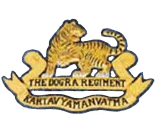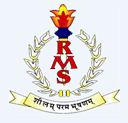
The National Cadet Corps (NCC) is the youth wing of the Indian Armed Forces with its headquarters in New Delhi, India. It is open to school and college students on voluntary basis as a Tri-Services Organisation, comprising the Army, the Navy and the Air Force. Cadets are given basic military training in small arms and drill. Officers and cadets have no liability for active military service once they complete their course.

The Dogra Regiment is an infantry regiment of the Indian Army. The regiment traces its roots directly from the 17th Dogra Regiment of the British Indian Army. When transferred to the Indian Army like its sister regiments, the numeral prefix was removed. Dogra Regiment Units Maximum filled with Rajputs And Sikh. Units of the Dogra Regiment have fought in all conflicts that independent India has been engaged in, making it one of the most prestigious and most decorated regiments of the Indian Army.
The Sainik Schools are a system of public schools in India established and managed by the Sainik Schools Society under Ministry of Defence (MoD). They were conceived in 1961 by V. K. Krishna Menon, the then Defence Minister of India, to rectify the regional and class imbalance amongst the officer cadre of the Indian Military. The primary objective of the Sainik Schools is to prepare students academically, mentally and physically for entry into the National Defence Academy (NDA) and Indian Naval Academy (INA). Sainik Schools, along with 1 RIMC and 5 RMS, contribute 25% to 30% officer cadets to NDA and INA. As of 2021, there were 33 Sainik Schools, and MoD will establish 100 more boarding Sainik Schools in public–private partnership (PPP) mode.
A King's commissioned Indian officer (KCIO) was an Indian officer of the British Indian Army who held a full King's commission after training in the United Kingdom, either at the Royal Military College, Sandhurst for infantry officers, Woolwich for artillery officers, and Chatham and Woolwich for engineer officers. They had full command over British and Indian troops and officers. In contrast, the Indian commissioned officers (ICOs), who were trained at the Indian Military Academy at Dehra Dun, and the Viceroy's commissioned officers (VCOs), only had authority over Indian troops and officers. KCIOs were introduced in the early 20th century under the Indianisation process. They were equivalent in every way to the British officers holding a King's commission. In essence, they were commissioned by the King himself at a special induction ceremony. They held the same ranks and privileges as British officers. In fact, most KCIOs served on attachment to a British unit for a year or two early in their careers.

The Rashtriya Indian Military College is a military school for boys situated in Doon Valley, Dehradun in India. The RIMC is a feeder institution for the National Defence Academy, Indian Naval Academy and subsequently the Indian Armed Forces. Rimcollians, the name by which alumni of the RIMC are usually denoted, have gone on to hold the highest ranks in the Army, Navy and the Air Force of India, Pakistan and Bangladesh.

The Indian Military Academy (IMA) is one of the oldest military academies in India, and trains officers for the Indian Army. Located in Dehradun, Uttarakhand, it was established in 1932 following a recommendation by a military committee set up under the chairmanship of General Sir Philip Chetwode. From a class of 40 male cadets in 1932, IMA now has a sanctioned capacity of 1,650. Cadets undergo a training course varying between 3 and 16 months depending on entry criteria. On completion of the course at IMA cadets are permanently commissioned into the army as Lieutenants.
The Indian Defence services have established numerous academies and staff colleges across India for the purpose of training professional soldiers in military sciences, warfare command and strategy, and associated technologies.
Rashtriya Military School– Ajmer, established in 1930, is a boys' educational institution in Ajmer, Rajasthan, India.
Lieutenant General Ranjit Singh Dyal, PVSM, MVC was an Indian Army general and an administrator. As a soldier, Ranjit Singh led the capture of the Haji Pir pass by the Indian army during the 1965 war with Pakistan. He also drew up the plans for Operation Blue Star, and served as the General-Officer-Commanding-in-Chief of the Southern Command. Later, he served as Lieutenant Governor of Puducherry and the Andaman and Nicobar Islands.

Cadet college is a special military high school system of British Raj and later, Pakistan and Bangladesh.

Rashtriya Military School, Belgaum is one of five military schools in India. Entrance tests for the military schools are held every year in December. About 70,000 to 80,000 students attend this test and around 350 students are selected. The schools are run by the Ministry of Defence, Government of India.
Major General Hira Lal Atal was an Indian Army officer in the British Indian Army from 1925 until 1947 and the Indian Army from 1947. He became the first indigenous Adjutant General of independent India. He was instrumental in designing the Indian Armed Forces’ highest award for bravery, the Param Vir Chakra. Later, he became Chief Commissioner of Tripura.

Rashtriya Military School, Dholpur is one of five military schools of India. It is situated in Dholpur in Rajasthan and was established in 1962 by a former defence minister, Krishnan Menon, to facilitate education of the children of the Defense personnel as well as the civilians. Military Schools in India were previously known as King George Royal Indian Military College.

The Officers Training Academy (OTA) is a training establishment of the Indian Army that trains officers for the Short Service Commission (SSC). The 49-week course at the OTA prepares graduates for all branches of the Army, except for the Army Medical Corps. Established in 1963, the first academy is located in Alandur, a southern neighbourhood of Chennai. OTA chennai has an impressive tally of gallantry award including 1 Param Vir Chakra, 8 Ashoka Chakra, 10 Maha Vir Chakra, 22 Kirti Chakra, 63 Vir Chakra, 119 Shaurya Chakra and 587 Sena Medal earned by the officers commissioned from this academy bears testimony to the Valour and dedication displayed by the Alumni. A new academy was set up at Gaya in 2011; but was given the go-ahead in December 2019 to be disbanded.

Rashtriya Military School Bangalore is a military boarding school in Bangalore, Karnataka, India. It was established on 1 August 1946 and is one of only five RMS of its kind in India; the other four being Chail Military School established in 1922, Ajmer Military School in 1930, Belgaum Military School in 1945, and Dholpur Military School in 1962. The cadets enrolled in these schools are known as Georgians, after their founder father King George VI.

The Army Training Command, abbreviated as ARTRAC, is one of the seven commands of the Indian Army. It is currently based at Shimla. It was established in 1991.
Hugh CatchpoleCBE HI was a British educationist and philanthropist, mostly active in British India, and later India and Pakistan. He was a teacher and administrator in military colleges and schools such as Prince of Wales Royal Indian Military College, Pakistan Air Force School in Sargodha and Abbottabad Public School. He was the founder principal of Cadet College at Hasan Abdal. For 5 years of his life, he was in the Royal Army and for over 60 years, he was associated with schools in India and Pakistan.

Lieutenant General Chandi Prasad Mohanty is a retired General Officer in the Indian Army. He was the 42nd Vice Chief of the Army Staff and assumed office on 1 February 2021, following the retirement of Satinder Kumar Saini. He was previously the General Officer Commanding-in-Chief (GOC-in-C) of the Southern Command, assuming command on 30 January 2020. He was trained at RIMC Dehradun.

Major General Siri Kanth Korla, PVSM, DSO, MC was a general officer in the Indian army who served in the Second World War and the Indo-Pakistan War of 1965. He served in the British Indian Army from 1934 to 1947, and the Indian Army from 1947 to 1971. Korla was known as one of the great company commanders of the Burma Campaign, and among the most highly and heavily decorated Indian officers of the British Indian Army during the Second World War.















